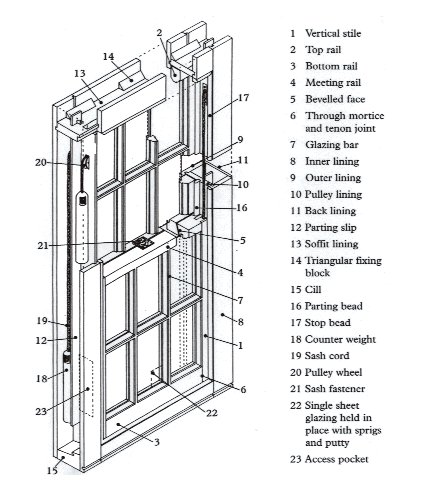Glossary

-
Access/Weight pocket - The removable timber piece within the boxes giving access to the weights for re-cording. See diagram (23)
-
Back lining - See diagram (11)
-
Bevelled Face - See diagram (5)
-
Bottom Rail - The lowest element of the bottom sash See diagram (3)
-
Cill - The lower element of the box. See diagram (15)
-
Counterweight - See diagram (18)
Georgian windows
-
Glazing bar - Slender timber bars, with decorative moulding on the inner face, that forms a grid-like framework that holds panes of glass within a timber window frame See diagram (7)
-
Horns - Small projecting spurs of timber on a sash window (hanging down from the top sash and projecting up from the bottom sash), introduced from the mid-19th century to strengthen the joints.
-
Inner lining - See diagram (8)
-
Meeting Rail - The horizontal part of a sash. See diagram (4)
-
Outer lining - See diagram (9)
-
Parting Bead - Traditionally a timber element Located between two sashes to keep them apart. See diagram (16)
-
Pulley lining - See diagram (10)
-
Pulley wheel - See diagram (20)
-
Sash - That part of a window frame that slides up or down, usually counterbalanced on weights. A sash window is a window that contains such sliding sashes.
-
Sash cord - See diagram (19)
-
Sash fastener - See diagram (21)
-
Soffit lining - See diagram (13)
-
Staff Bead or Stop Bead - The timber installed around the box's inside face to retain the lower sash within the unit. See diagram (17)
-
Through Mortice & tenon joint - See diagram (6)
-
Top Rail - See diagram (2)
-
Vertical Stile - See diagram (1)